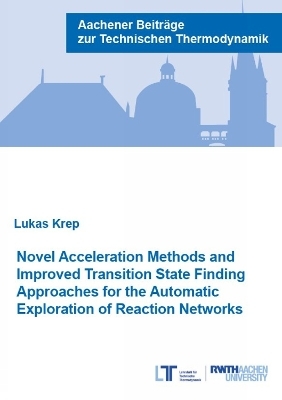Novel Acceleration Methods and Improved Transition State Finding Approaches for the Automatic Exploration of Reaction Networks
Seiten
Reaction models are important for many engineering tasks, such as the optimization of internal combustion engines or production lines in the chemical industry.
The automated reaction space exploration method ChemTraYzer attempts to alleviate the often time-consuming reaction model development process. ChemTraYzer uses reactive Molecular Dynamics (rMD) simulations to find the underlying reactions of the reaction process. Coupling the rMD output to quantum-mechanical reoptimizations of reactant, product and transition state (TS) geometries and to transition state theory, allows ChemTraYzer to produce kinetic and thermochemical data with the low uncertainties,which are required for many reaction model applications. In this thesis, I address two major issues of the ChemTraYzer method. First, I introduce two acceleration techniques for the rMD simulations, the pressure-accelerated Dynamics (pAD) and ChemTraYzer-Temperature-Accelerated Dynamics (ChemTraYzer-TAD) methods, to extend the applicability of rMD to reaction processes that occur on longer time scales than the nanosecond. The acceleration techniques are designed to work with minimal a-priori knowledge of the reaction systems, as they are meant for the exploration of unknown reaction space. With the pAD method, I describe a methodology to choose elevated simulation pressure and temperature to speed up the occurrence of reaction events without simulating a biased reaction network.
ChemTraYzer-TAD is a progression of the pAD method. ChemTraYzer-TAD allows for higher simulation temperatures than pAD and allows for high boost factors of 108 as demonstrated in our ChemTraYzer-TAD case study. Both methods are applied to case studies of low-temperature ignition reaction processes. Second, I improve the performance of the automatic TS searches, which are a bottleneck in the ChemTraYzer methodology, by introducing a recovery method for failed TS searches. Our new recovery method improves the overall TS search success rate by up to 10 percentage points to a total of 48%. Finally, I demonstrate the practical usability of ChemTraYzer for automated reaction space exploration using case studies of chlorinated dibenzofurane formation and decomposition processes.
The automated reaction space exploration method ChemTraYzer attempts to alleviate the often time-consuming reaction model development process. ChemTraYzer uses reactive Molecular Dynamics (rMD) simulations to find the underlying reactions of the reaction process. Coupling the rMD output to quantum-mechanical reoptimizations of reactant, product and transition state (TS) geometries and to transition state theory, allows ChemTraYzer to produce kinetic and thermochemical data with the low uncertainties,which are required for many reaction model applications. In this thesis, I address two major issues of the ChemTraYzer method. First, I introduce two acceleration techniques for the rMD simulations, the pressure-accelerated Dynamics (pAD) and ChemTraYzer-Temperature-Accelerated Dynamics (ChemTraYzer-TAD) methods, to extend the applicability of rMD to reaction processes that occur on longer time scales than the nanosecond. The acceleration techniques are designed to work with minimal a-priori knowledge of the reaction systems, as they are meant for the exploration of unknown reaction space. With the pAD method, I describe a methodology to choose elevated simulation pressure and temperature to speed up the occurrence of reaction events without simulating a biased reaction network.
ChemTraYzer-TAD is a progression of the pAD method. ChemTraYzer-TAD allows for higher simulation temperatures than pAD and allows for high boost factors of 108 as demonstrated in our ChemTraYzer-TAD case study. Both methods are applied to case studies of low-temperature ignition reaction processes. Second, I improve the performance of the automatic TS searches, which are a bottleneck in the ChemTraYzer methodology, by introducing a recovery method for failed TS searches. Our new recovery method improves the overall TS search success rate by up to 10 percentage points to a total of 48%. Finally, I demonstrate the practical usability of ChemTraYzer for automated reaction space exploration using case studies of chlorinated dibenzofurane formation and decomposition processes.
| Erscheinungsdatum | 25.03.2023 |
|---|---|
| Reihe/Serie | Aachener Beiträge zur Technischen Thermodynamik ; 40 |
| Verlagsort | Aachen |
| Sprache | englisch |
| Maße | 148 x 210 mm |
| Gewicht | 284 g |
| Themenwelt | Naturwissenschaften ► Physik / Astronomie ► Thermodynamik |
| Technik | |
| Schlagworte | Automatic Exploration • Chemie • Dissertation • Innovation • Reaction Networks • RWTH • Technik • Technische Thermodynamik • Thermodynamik |
| ISBN-10 | 3-95886-480-5 / 3958864805 |
| ISBN-13 | 978-3-95886-480-1 / 9783958864801 |
| Zustand | Neuware |
| Haben Sie eine Frage zum Produkt? |
Mehr entdecken
aus dem Bereich
aus dem Bereich
Hauptsätze, Prozesse, Wärmeübertragung
Buch | Softcover (2023)
De Gruyter Oldenbourg (Verlag)
CHF 62,90




